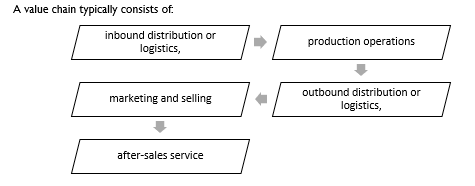A value chain is an interlinked value-adding activity that converts inputs into outputs which, in turn, add to the bottom line and help create competitive advantage. The chain of activities gives the products more added value than the sum of added values of all activities.

These activities are supported by:
Purchasing or procurement: If the farmer takes calculated decisions on which seed to purchase, which chemicals to use, water and electricity usage and other inputs, he can maintain optimum production whilst farming becomes more sustainable.
Research and development: Ongoing research ensures that agriculture remains to be a sustainable business. There are numerous sources for a farmer that he can stay updated on the latest research to remain competitive.
Human Resource Development: The efficient utilisation of human resources within the boundaries of labour legislation remains a challenge to farmers.
Producers organisations: RPO is the main organisation assisting cattle farmers in all aspects, including supply chain information and research and development. More producer organisations exist for other producers.
The value chain concept provides a way of understanding relationships between businesses, methods for increasing efficiency, and ways to enable businesses to increase productivity and add value. Value-chain approaches in the agriculture sector are a vehicle for linking small businesses to markets and are essential for improving South Africa’s economy and reducing poverty.
To understand the comprehensive nature of the meat production supply chain, we need to take a systems approach. The diagram below, explains the supply chain by putting each role player into perspective:

In “Strategic Approach to Farming Success”, Nell and Napier ask: “When you get up in the morning. Do you say, ‘I am a cattle farmer or do you say, ‘I am a food producer’. In which way do you talk to yourself? The really winning producers these days have redefined the way they view themselves. At the very least they say, ‘I am a food producer’. Now, when they say they are food producers, rather than cattle farmers, they immediately think “I need to build relationships throughout the supply chain, all the way to the consumers and I need to think about what the market dictates- seeing that I am producing food for the market.” An average farmer with a good holistic strategy is in a much better position than an outstanding farmer who is only production focused.
The new farm, the new farming business, the new agriculture tells us that the farm cannot be a fragment or an isolated part of the food production system, it has to be integrated, planned, constructed and farmed with a lively awareness of what is happening in the value chain.
Click here to view a video that explains the food value chain explained.
How the Value Chain Works
At its simplest, a value chain is an activity path through an organisation, outlining what and how the organisation conducts its business.
Capturing the value generated along the chain is the new approach taken by many management strategists. For example, a fruit farm that needs its products to be packed will require its packhouse to be located nearby its farm. This will maintain the quality of the product and minimise the cost of transportation.
A value chain can be a very helpful tool for understanding the difference between two organisations that appear to be functioning in similar ways in the same sector. This is because organisations can construct their value chains in very different ways, thus creating a competitive advantage.